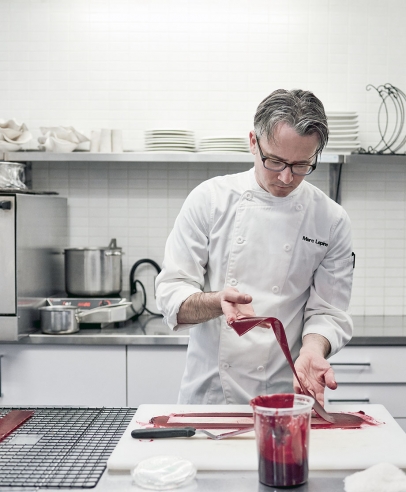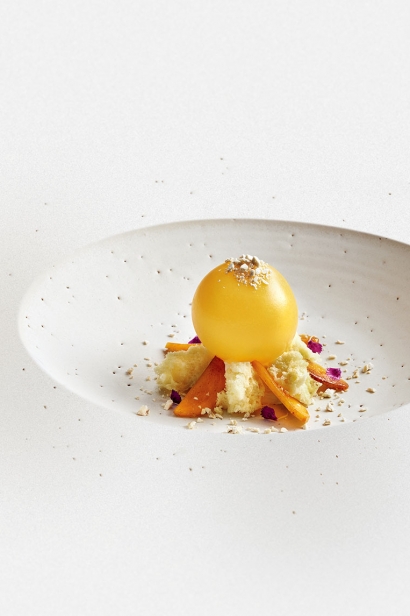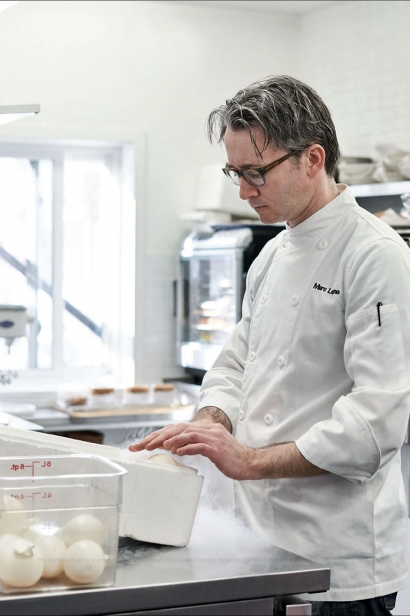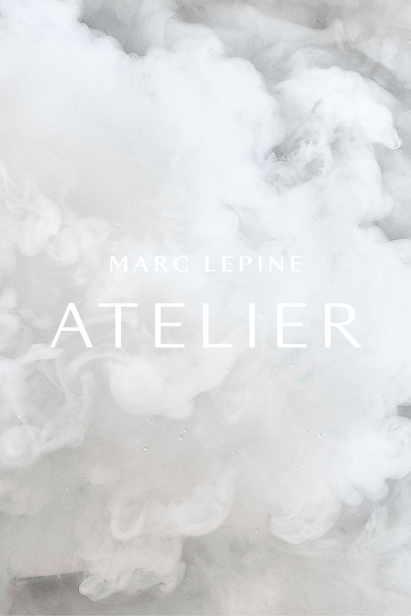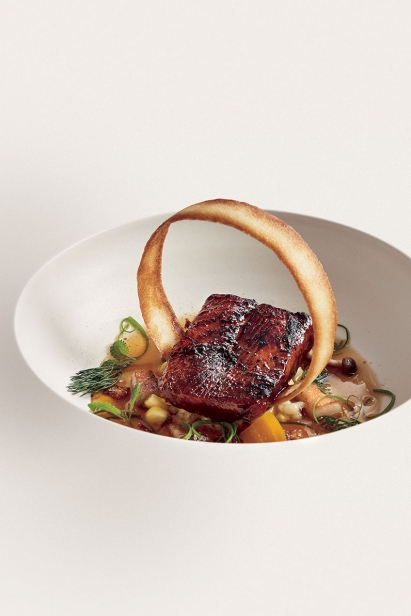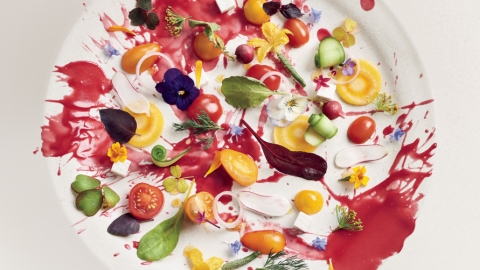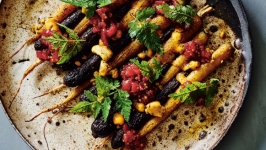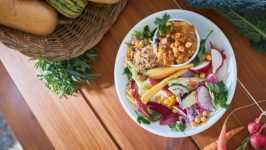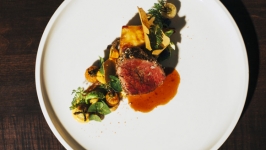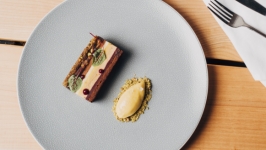Atelier
There's the air of whimsy and definitely a whiff of mad scientist when it comes to Marc Lepine’s new book. Part cookbook, part coffee table tome, it’s a work of considerable artistry, much like the food he serves at his 10-year old restaurant, Atelier.
The book opens with a fantastically evocative picture of Lepine dressed in black, against a black background, holding a smoking glass sphere. Looking directly at the camera with an almost-smile, Lepine appears to be inviting the reader in to find out what exactly is hidden between the covers here.
An opening series of essays give a good idea of the man and his kitchen. He is honest about his failures and cheerful about success, but what shines throughout the book, the photographs and an interview, is Lepine’s sense of fun. You can see it in the photographs of food that looks nothing like food you’ve eaten before and you can hear it in his written voice. He even states it clearly, “to create memories for our diners, we wanted the food to be thrilling and delicious, but also amusing. And not in a ‘Ha ha, how interesting…’ sort of way. We were hoping for belly laughs.”
Certainly a series of notable events, listed in the book, that Lepine and his team have hosted around town display a serious commitment to fun. One, in August 2015, saw the Atelier crew take the tasting menu on the road. Using social media, they posted a picture clue each hour and people had to figure out where they were around town. In each of the 12 spots designated spots, they’d serve a dish for a toonie. “At one stand, on the sidewalk outside some downtown building, a security officer told us to scram. When we didn’t, he called a bylaw officer, but we skedaddled to the next location before the officer had a chance to show up.” Frankly, that’s a hilarious prank for any restaurant to play, but somehow, when it’s a highly revered establishment that serves only a 12-course tasting menu, the chef-owner of which was recently voted "Canada’s most innovative chef," it doubles the fun factor.
Complacency is the enemy of creativity and Lepine and his team of five or six chefs make sure that they are constantly creating. “We build recipe development into our day,” explains Lepine. “Sometimes it takes one or two tweaks to get a dish just right, sometimes six or more, but we do it in a collaborative way and everyone has input. We don’t want just OK, we want WOW! That was awesome,” he says. Each chef has an idea for a new dish in a different way; for Lepine, the idea is initially primarily visual.
“For me, the plate is always in my head. Other chefs are more driven by ingredients or technique, but I see the dish — its colours and shapes, the flow of it, how the eater might interact with it and react to it — before I see what’s in it. Then I discuss that vision with the team,” he writes.
Indeed, Lepine admits to being very demanding of his chefs about presentation. “When it comes to presenting the same dishes repeatedly throughout a season, we need to ensure consistency across plates. Presenting the components with precision, down to the smallest detail, is essential,” he writes. “It’s something I’m forever on my team about. If a sorrel leaf stem is broken, get another one. If three dots of mayo need to be the size of a dime, don’t make them the size of a loonie. When laying down a gel strip on a plate, place it off-centre.”
As the plate hits the table in front of us, we eat with our eyes before any other sense is engaged. But it’s our taste buds that make the final judgement. At every restaurant, but particularly Atelier because it’s trying to draw attention to presentation, texture and taste, it’s a balancing act not to fall foul to style over substance. “And always — no matter how brilliant the technique, the trick, the texture or how remarkable the dish looks — it always comes back to this: Does it taste great?” Lepine writes.
Most dishes on the menu stay for around three months, tweaked as new produce comes into season. The changing seasons will dictate when a dish has to go, but it’s never a problem, “because we always have at least one, usually three or four others that we are working on,” Lepine explains.
While this is a cookbook designed for professionals, there are elements that should not be beyond a competent home cook. One of those is Splat, Lepine’s favourite photo and one of the simplest recipes to prepare. It’s a Jackson Pollock-esque display of colour and celebration of the autumn harvest, requiring nothing more complicated than a beet puree and confit lemons, combined with cucumber, yellow beets, cherry tomatoes, radish, Feta cheese, Swiss chard, and a whole bunch of herbs and edible flowers.
Many of the ingredients for this and other recipes in the book come from the garden behind Atelier. “We had over 45 different types of plants growing back there and harvested over 2,000 cherry tomatoes this year, as well as countless radishes, cucumbers, herbs, edible flowers, peppers,” says Lepine, with a tone of satisfaction. And for the rest of his extensive, often obscure ingredients, he relies on a network of more than 50 suppliers.
While high-quality ingredients are the basis of any good meal, it’s what the Atelier team does with them that makes them sing. Nothing is as you would expect, and the same goes for the kitchen. There is no oven. No deep fryer. “These things just took up too much space. And while that was one reason not to have them, the main reason was that I wanted to outfit the kitchen with a bunch of toys so that it would be fun!” Lepine’s favourite piece of equipment is a dehydrator — basically a machine for drying out food, but for the home cook he recommends starting with an immersion circulator, otherwise known as a sous-vide machine. “It requires minimal reading to get it to work,” he says.
Lepine does admit to owning a stove at home. “It’s gas,” he confesses, “and I cook quite simply at home.” Of his two children, one is an adventurous eater, the other, not so much. This doesn’t worry him one bit; “most of my childhood pleasures were for the cellophane food groups — potato chips, factory cakes and pastries,” he confesses, “ I didn’t know what a tomato tasted like until I was 20. Truly.”
Before his tastebuds awoke, Lepine’s passions were chess and playing the piano. He still plays the piano at least once a week and continues to keep his mind sharp by playing chess daily. He is convinced that ordinary is boring, so perhaps it’s a combination of the artistry needed to play the piano well and the precision required of a serious chess player that combine to produce the decidedly not-ordinary dishes at Atelier. “Whimsy plays a vital role in plating the food,” he writes.
Whimsy is an ingredient at Atelier, showcased by the sharp photographs taken by Ottawa photographer Christian Lalonde. Shot over five days, the images make the food pop. Styled on white, custom plates of varying shapes, which often fade into the background, there are no props. It’s the food itself that takes centre stage, colourful and playful. “This is food in a very graphic presentation,” Lalonde says. “It’s so different from much of the food photography I do, because it’s like an art book and a coffee table book in one because of all that open space.”
Atelier
540 Rochester St., Ottawa, Ont.
atelierrestaurant.ca | 613.321.3537
Atelier by Marc Lepine with Anne Desbrisay, photography by Christian Lalonde, published by Figure 1, $55.


